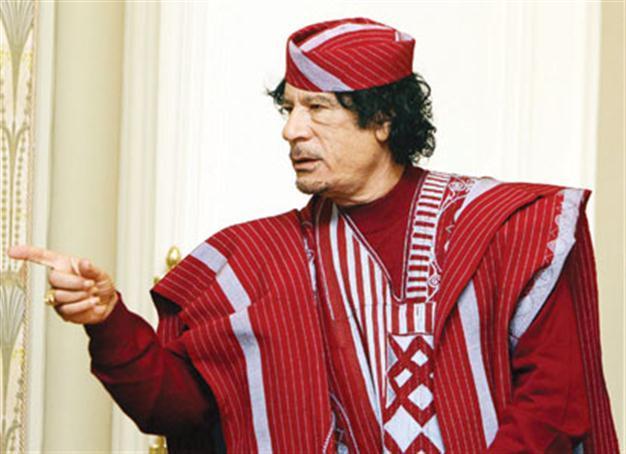World politics loses a fashion icon
MELİS ALPHAN

Col. Gadhafi. Sipa Press Photo.
He might have been the most ruthless of them all, but it would be unfair to deny that Col. Moammar Gadhafi put his own special touch on dictator fashion. Nobody can rock a curtain cloth like him. He brought color to the world of politics with a fair amount of eccentricity.
Remember the remark by Israeli President Shimon Peres: “Who needs this Gadhafi person? He should go work for Dior instead. He changes his outfit every day, investing thousands of dollars in strange hats, crappy dresses, wasting his money… Who needs him? You tell me, what for?”
Nonetheless, the infamous dictator had an outfit for every occasion. He was a mix & match master.
If you are to look at the photo taken of the G8 Summit leaders in 2009, you will know what I mean. In a lineup of leaders in dark suits including Silvio Berlusconi, Dmitry Medvedev, Nicolas Sarkozy and Barack Obama, Gadhafi looked like he jumped off the stage of “Saturday Night Fever” with his white suit, black Arabic “bisht” (cloak) and a brooch in the shape of Africa.
The color white was a favorite of Gadhafi. He often wore crowd-pleasing white with a spark of gold. When he was not wearing his uniform, he sported tailored, but softer, two-piece suits with stand-up collars and smart, center-line button closures. And at all times, he flaunted contrast-colored capes.
His most glamorous – or extravagant – costumes were composed of embroidered “kufi” (hats) with extraordinary combinations of patterns and textures. When traveling with his 40 virgin bodyguards, he usually went for his traditional uniform with epaulets.
For more than 40 years, Gadhafi, the longest-serving leader in both Africa and the Arab world, dressed up according to his political agenda. He communicated his political propaganda through his clothes. The fits of his clothes were inspired by those of African kings. He wore the Islamic green as well as prints referring to Africa and the Arab world. One could see the continent of Africa on his shirts.
In his early years, he wore military outfits. He wanted to show that he was a secular and revolutionary officer. It did not take long for him to smarten up his military garb with striking accessories.
Later on, as he skipped dressing like a political leader or a soldier, he started wandering around in clothes suitable for a king. At a time when even Saddam Hussein and Hosni Mubarak put on suits, Gadhafi did not adopt Western styles and instead opted for his personalized traditional wardrobe.
He himself was quite sure of his dress sense too. Why else would his minister of cultural affairs write a letter to a U.S. magazine editor suggesting that the Libyan leader’s wardrobe get a retrospective at the Metropolitan Museum of Art and that his personal style had influenced celebrities such as Michael Jackson?
Apparently, Gadhafi was fond of plastic surgery, too. Earlier this year, a Brazilian surgeon named Dr. Liacyr Ribeiro revealed to the Associated Press that the Libyan leader requested plastic surgery in 1995 because “he had been in power for 25 years at that time and did not want the young people of his nation to see him as an old man.” The doctor recommended a facelift, but Gadhafi refused. Instead “he received hair plugs and had fat from his belly injected into his face to counteract the appearance of aging. The operation occurred in the middle of the night in Gadhafi’s compound in Tripoli. He insisted on local anesthesia, so he could remain awake during the procedure. Midway through the surgery, he paused to snack on a hamburger.”
The late dictator could not have his wardrobe displayed at the Met during his lifetime, but now that he is gone, the wardrobe surely deserves to be shown in a retrospective somewhere.
















